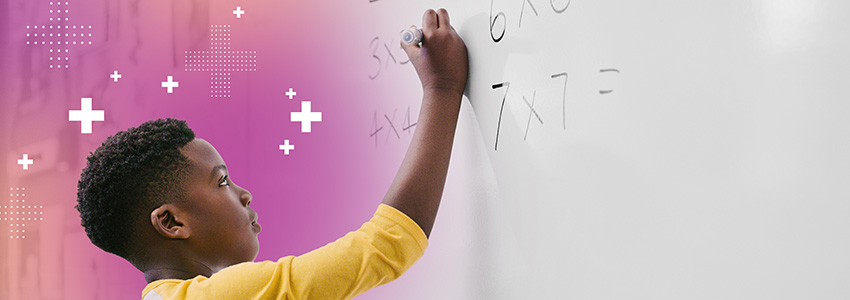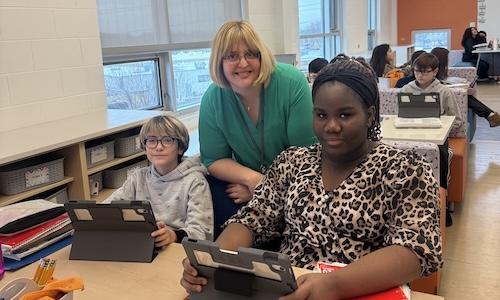
As with many things in education, the term “enrichment” has come to mean different things to different people. For some, enrichment refers to supplemental classroom content or after-school activities that go beyond the standard curriculum. For others, it means a group of students who get pulled from the regular class to engage in more challenging content or gifted and talented activities. Math enrichment in particular can mean a lot of things.
When I first started teaching, I thought of enrichment as the puzzles and activities that I had on hand for fast finishers. I used these frequently in math when I thought I needed something to challenge kids who clearly (or so I thought) understood the math. Both of those assumptions—that what I was giving those students was enrichment and that finishing quickly meant students understood math deeply—were among the many things that I misunderstood as a beginning teacher. So, what is a better model for enrichment in math?
Math enrichment for all
There are several issues with my original approach to enrichment. First, it provided students who might actually have been ready for more challenge with glorified busywork that didn’t deepen their understanding of math. Second, it created a delineation between regular (aka “boring”) math work and “fun” enrichment work. Finally—and most importantly—it reinforced the assumption that not all students were capable of deeper understanding of math or worthy of enrichment. If indeed there had been an activity of value, it would only have been offered to a select few students (and usually the same few), denying others the opportunity to explore math in a richer way. As Jennifer Piggott of the University of Cambridge’s NRICH Mathematics Project puts it, “Enrichment should pervade the curriculum as a whole and not simply be available to those who work fastest.”
Ironically, it wasn’t until I became an enrichment teacher that I was introduced to the concept of enrichment for all. My school had a two-tiered enrichment program. In addition to a traditional pull-out program, every class got multiple one-week enrichment sessions each year where I worked with the grade-level classroom teachers to create a unit that deepened on-grade content. The lessons were designed so that all students could participate in all activities but were purposefully open-ended enough to allow students to explore the content at different depths. In these whole-class sessions, I saw both high levels of engagement and an incredible depth of thinking by all students.
Setting things straight
Before digging further into enrichment, I want to clarify some terminology. First, let’s address the difference between “enrichment” and “acceleration.” Researchers Susanne Schnell and Susanne Prediger nicely distinguish the two concepts in their study “Mathematics enrichment for all—Noticing and enhancing mathematical potentials of underprivileged students as an issue of equity”: “Acceleration means learning mathematics in accelerated pace (mainly by taking special courses ahead of the normally scheduled year). Enrichment means to expand students’ experiences and skills by exposing them to rich learning processes.” They further distinguish two approaches to enrichment: enrichment by “broadening,” or the learning of extra topics or subjects, often via extracurricular programs, and enrichment by “deepening,” which focuses on greater depth and complexity with the current topic. I’m going to focus on enrichment by deepening.
Why math enrichment for all?
Numerous research studies have highlighted the fact that African American, Latino, and Native American students, English learners, students with disabilities, and students from lower socioeconomic backgrounds are significantly underrepresented in traditional gifted and talented programs. This can be attributed to multiple factors, ranging from biased or flawed entry criteria to lack of equal educational opportunities for all students. Couple this with inequitable access to on-grade instruction and high-quality instructional materials and you can see that some students face real barriers to accessing anything beyond low-level content.
NCTM’s position on Access and Equity in Mathematics Education calls out that “To increase opportunities to learn, educators at all levels must focus on ensuring that all students have access to high-quality instruction, challenging curriculum, innovative technology, exciting extracurricular offerings, and the differentiated supports and enrichment necessary to promote students’ success at continually advancing levels.” Schnell and Prediger propose that an enrichment for all approach is necessary to expose the potential of traditionally underserved students: “Only if the situation has a potential of becoming mathematically rich, then the student can show some potentials. And in longer-term perspectives: if the student experiences his or her mathematical potential in a mathematically rich learning situation, then the potential can become a stable characteristic of the student in the long run.”
Students who are perpetually underchallenged have little opportunity to showcase their potential. I also appreciate Schnell and Prediger’s use of the term “potential,” as it implies a more fluid and dynamic characteristic, which may appear situationally but can be nurtured and developed. By contrast, labels like “gifted” and “talented” tend to be approached as more static and “given by nature.”
Furthermore, studies have shown that access to enriching math content has a positive impact on students’ engagement and attitudes. One study examined the Secondary Mathematics Masterclass program in the UK, which is designed to “inspire and engage young people in the art and practice of mathematics.” Students in the program reported enjoying learning “through experimenting rather than just being told something.” Over 60% felt the program improved their attitude toward and confidence in math, as well as their mathematical ability. John Hattie’s Visible Learning project cites attitude toward content domain as a factor with the potential to accelerate learning. All students need access to opportunities that support such positive experiences in math.
Getting started with math enrichment for all
Now that you understand the why behind enrichment for all, it’s time to get down to the nitty gritty of how to provide it. In their paper, Schnell and Prediger propose seven design principles for fostering all students’ mathematics potential:
- Provide enrichment in whole-class settings
- Enrich and deepen topics related to the on-grade curriculum
- Utilize low-floor/high-ceiling problems to allow for differentiation and challenge
- Engage students with rich mathematical problems
- Use open-ended problems to give students experiences of autonomy and competence
- Value cognitively demanding processes over “perfect products”
- Support positive engagement through discussion of students’ ideas and thinking
Below are three specific ways to put some of these principles in action. The good news is you may already be doing some of these!
1. Support positive engagement through discussion of student’s ideas and thinking
Many college- and career-ready standards include practice standards requiring students to articulate their thinking and critique others’ reasoning. Thus, many teachers already include mathematical conversations as a regular part of their classroom. The importance of this cannot be understated. In his research on high-growth strategies, Chase Nordengren states that “Student conversation is the most concrete representation of students’ higher order thinking. By introducing student discourse early and often, high-growth teachers create opportunities for all students to engage in higher-order thinking around grade-level topics.”
But not all student conversations are alike. To be effective, the discourse should be focused on high-level questions and big topics rather than solely on procedural questions. Research has shown that high-level questions that prompt students to reflect on and consolidate their learning improve student performance. While students may start by explaining their approach to a problem, they can be prompted with high-level questions to see connections to previous problems and big mathematical ideas. Delving into big mathematical ideas supports the design principle of deepening and enriching on-grade topics.
When planning questions for a unit or lesson, think about the mathematical ideas that underlie the topic of the lesson and what you might ask to help students make these connections. For example, when discussing a problem about dividing fractions, students can be directed to discuss larger topics like the meaning of division, the relationship between division and multiplication, as well as fundamental fraction concepts. NWEA’s free Formative Conversation Starters provide a great model for using a single problem as a jumping-off point for a deeper discussion of big math ideas. For tips on how to implement these conversations, check out my colleague Kailey Rhodes’s post “Formative conversations and the pursuit of equity in math instruction: 4 light bulb moments.” Or read my colleague Ted Coe’s post on student discourse to learn more about the connection between high-level questions and strategies for high growth for all.
Open-ended, general questions like “How does that work?” “Is that always true?” and “What do you notice/wonder about…” also help promote deeper thinking over quick responses.
2. Engage students with rich mathematical problems
Problem-solving is a standard part of all math classes. Traditionally, this takes the form of routine word problems where students apply the skill learned in the previous lesson to a real-world context. Such problems rarely demand deep thinking of students.
In his TED Talk, math teacher Dan Meyer talks about how he revises the problems in his textbook to support “patient problem-solving,” where students must ask questions, rely on their intuition, build the problem themselves, and actively and iteratively make decisions. His Three-Act Tasks present students with limited information, usually in multimedia form, and a question to answer. Through discussion, students ask questions, generate ideas, determine what information they need, gather that information and then work on answering the original question, self-monitoring, and changing course as needed. They are actively engaging in mathematical thinking in a way that they don’t when solving a rote problem with a straightforward solution path.
Fermi problems are another example of problems that support creative thinking. Named after physicist Enrico Fermi, these are open-ended problems that push solvers to determine a solution path, make and test assumptions, and sometimes make reasonable estimates to solve. They also support a collaborative group approach and mathematical modeling. An example of a Fermi problem is, “How much water does your household use in a week? Can you answer this without looking at a water bill?” As with Three-Act Tasks, students must determine what information they need and determine a solution path, which they must monitor and change as needed.
3. Utilize low-floor, high-ceiling problems to allow for differentiation and challenge
Low-floor, high-ceiling tasks are designed to allow all students to participate and contribute to the conversation while giving those with deeper understanding something chewier to wrestle with. Or as described on NRICH’s site, “everyone can get started and everyone can get stuck.” Problems are structured so that there is more than one way to solve them, and there is room for students to explore different approaches and wrestle with bigger mathematical concepts.
Educator and researcher Marian Small has created a type of low-floor, high-ceiling task that she calls open questions. These types of questions allow for natural differentiation and, like the Formative Conversation Starters, also use a single question to explore big ideas in math through rich classroom discussions. Here’s an example of an open middle question: ____ is 4/5 of ____. This presentation allows all students entry to the problem. Every student can respond in some way, and the variety of responses can be leveraged to raise the level of the discussion for the entire class. The blanks can be filled with various types of numbers: whole numbers (4 is 4/5 of 5 or 72 is 4/5 of 90), fractions (12/25 is 4/5 of 6/10), or decimals (0.8 is 4/5 of 1). Students who show deeper understanding can easily be asked to stretch their thinking.
Small recommends circulating around the room to monitor student work. If you feel a student isn’t stretching themselves as much as they could, tell them that many people have similar answers and request that they find an answer with, say, greater numbers or a different type of number. All of this can lead to conversations about different types of numbers as well as the meaning of multiplication and scaling. Open questions like these help students understand that not all of math is about following a single path to an answer but, instead, can be about flexible thinking and creativity.
A note about technology
Technology has become an integral part of education. As with all educational tools, its uses should be carefully considered. While online programs can support math enrichment for all, care must be taken to ensure that they do not either become digital versions of the puzzles I gave to my fast finishers or claim to accelerate learning without building solid conceptual understanding. Online communication and collaboration tools can be a great way for students to model, map, and share their mathematical thinking with others. Check out “75 digital tools and apps teachers can use to support formative assessment in the classroom” to find some that might work for your class.
Whenever students are learning online, have them explicitly connect that work to whole-class content and teach them to think metacognitively about the material they are interacting with. Both strategies support higher-order thinking and retention of knowledge.
Changing minds
Shifting to an enrichment-for-all approach can unlock the mathematical potential of all students. To get started, think about how you can build on what you already do in your classroom to provide open-ended, rich explorations of math for all students. Feel like you need some more support? We’ve got you covered with the high-quality resources listed below.
- 3 Act Task File Cabinet. Educator Graham Fletcher has a host of resources on his site, including links to Three-Act Tasks for a wide array of grades organized by big ideas and standards.
- Dan Meyer’s Three-Act Math Tasks. This Google Sheet contains links to Three-Act Tasks, primarily for middle and high school, filterable by CCSS standard and mathematical practice.
- Formative Conversation Starters. This is our free resource for grades 2–8. Each grade-level document provides an overview of how to implement the conversations, problems to get the conversations started, questions, and possible student responses.
- Geogebra Open Middle Exercises. This site provides online, interactive problems similar to Marian Small’s open problems, organized by domain and grade band.
- NCTM Asking Questions and Promoting Discourse. This site provides a list of strategies and resources for supporting rich questions and conversations in your classroom. Links are provided to K–12 Notice and Wonder lesson plans designed to broaden student thinking and elicit conversations and creative thinking. A PowerPoint also provides tips for promoting discourse, including an overview of the five practices for orchestrating productive mathematical discussions.
- NCTM’s Game of the Year. Each year, NCTM creates a long-term, open-ended math challenge based around the numbers in the year. For 2024, the challenge is to use the digits in the year 2024, plus operational and grouping symbols, to write expressions representing the counting numbers 1 through 100.
- NCTM Notice and Wonder. This site contains a host of resources designed to support mathematical curiosity and engagement. Note that some resources require NCTM membership.
- NRICH. This site, developed by the mathematics faculty of the University of Cambridge, offers free curriculum-linked resources and challenging math problems plus low-floor, high-ceiling problems designed to engage students ages 3–18. There are teacher, student, and parent sections of the site, all of which contain problems and activities organized by grade ranges and content.
- One, Two…Infinity. Marian Small’s website lists her various publications related to enriching math activities and open questions. The presentations section provides copies of PowerPoints organized by grade band or mathematical topics, and there is also an open problem of the week. These presentations are loaded with free examples of open questions. You can also watch a free webinar where she discusses open problems on NCTM’s website.
- Openmiddle.com. This site contains a large number of printable K–12 open problems searchable by grade, domain, and Common Core standard. Student sheets can be printed in English, Spanish, and French.







